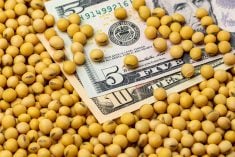Throughout the winter and early spring period, feeder cattle prices have been trending higher led by strength in beef values throughout the food processing chain.
However, it appears consumer demand is now starting to ease, given historical high retail values. Restaurants are also cutting costs or serving smaller portions in order to reduce the effect of higher beef values on the consumer. Wholesale beef prices have dropped for the second week in a row and the market for fed cattle has stalled for the third week in a row.
Read Also

U.S. grains: Soy futures post biggest monthly gain in nearly five years on China trade optimism
U.S. soybean futures climbed to a 15-month high and posted their biggest monthly gain in nearly five years on Friday following a rally fueled by the prospect of revived exports to China.
This is the behaviour of the beef complex at record highs. Canadian exports of live cattle and fresh or chilled cuts to the U.S. have surged since late March, which is abnormal compared to longer-term trends. Pen closeout break-even prices for August and September are creeping higher while barley prices in the Lethbridge area have reached the highest levels since last fall at $195 per tonne delivered. The overall environment looks like the feeder market will stabilize moving forward and the upward trend may be coming to an end. The bullish market needs to be fed every day to continue higher — and the risks that drove feeder prices higher are now turning neutral to bearish from current levels.
Western Canadian feeder cattle prices were steady last week in comparison to seven days earlier. Ligher auction market volumes were met with uneven buying interest and quality feeder cattle supplies have sharply declined over the past couple weeks. A group of 50 exotic steers averaging 800 pounds sold for $182 per hundredweight (cwt) in central Alberta. A smaller group of larger-frame Simmental-based steers weighing just over 600 lbs. sold for $212/cwt north of Calgary. It appears the heavier-weight cattle have gained on the lighter categories in an effort to capture the nearby feeding margins. The psychology has changed; feeding longer-term cattle may now endure more adverse risk, especially given the recent strength and uncertainty in the feed grain complex.
Buying interest for grassers appears to be limited at the higher levels. The farmer/cattle producer is still holding a fair amount of unsold grain or undelivered sold grain. In any case, cash flow has become a major issue and with seeding right around the corner, these producers are shying away from grazers and preserving capital for their main income source: grain production.
— Jerry Klassen is a commodity market analyst in Winnipeg and maintains an interest in the family feedlot in southern Alberta. He writes an in-depth biweekly commentary, Canadian Feedlot and Cattle Market Analysis, for feedlot operators in Canada. He can be reached by email at [email protected] for questions or comments.












